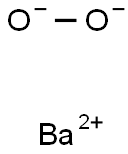과산화바륨
|
|
과산화바륨 속성
- 녹는점
- 450 °C
- 끓는 점
- losesO2 at 800°C
- 밀도
- 4,96 g/cm3
- 인화점
- 21 °C
- 용해도
- reacts with dilute acid solutions
- 물리적 상태
- 가루
- Specific Gravity
- 4.96
- 색상
- 하얀색
- 수소이온지수(pH)
- 12 (20°C, 10g/L in H2O, slurry)
- 냄새
- 냄새 없는
- 수용성
- 물에 불용성
- 감도
- Moisture Sensitive
- Merck
- 14,989
- 안정성
- 안정적인. 강산화제 - 가연성 물질과 접촉하면 화재가 발생할 수 있습니다. 유기 물질, 가연성 물질, 환원제, 대부분의 일반적인 금속과 호환되지 않습니다.
- LogP
- -0.425 (est)
- CAS 데이터베이스
- 1304-29-6(CAS DataBase Reference)
안전
- 위험 및 안전 성명
- 위험 및 사전주의 사항 (GHS)
| 위험품 표기 | O,Xn | ||
|---|---|---|---|
| 위험 카페고리 넘버 | 8-20/22 | ||
| 안전지침서 | 13-27 | ||
| 유엔번호(UN No.) | UN 1449 5.1/PG 2 | ||
| WGK 독일 | 1 | ||
| RTECS 번호 | CR0175000 | ||
| F 고인화성물질 | 3-9-23 | ||
| TSCA | Yes | ||
| 위험 등급 | 5.1 | ||
| 포장분류 | II | ||
| HS 번호 | 28164000 | ||
| 유해 물질 데이터 | 1304-29-6(Hazardous Substances Data) | ||
| 독성 | LD50 scu-mus: 50 mg/kg ZVKOA6 19,186,74 | ||
| 기존화학 물질 | KE-02083 |
과산화바륨 C화학적 특성, 용도, 생산
물성
고체 : 분말, 색상 : 흰색 또는 회색에서 흰색, 냄새 : 무취, 녹는점/어는점 : 450 ℃, 비중 : 5, 분자량 : 169.3 .용도
시약용 용도로는 화학적 방법에 의한 물질의 검출이나 정량을 위한 실험연구용으로 사용한다.개요
Barium peroxide, is a grayish-white powder that is slightly soluble in water. Barium peroxide is a dangerous fire and explosion risk in contact with organic materials and decomposes around 1450°F (787°C). It is also toxic by ingestion, is a skin irritant, and should be kept cool and dry in storage. The four-digit UN identification number is 1449. The primary uses of barium peroxide are in bleaching, in thermal welding of aluminum, as an oxidizing agent, and in the dyeing of textiles.화학적 성질
Barium peroxide is a grayish-white powder.물리적 성질
BaO2 is an iron gray or white powder. It is slowly decomposed in air, forming the hydroxide and oxygen. It does not dissolve in water, but can slowly hydrolyze, forming hydrogen peroxide in solution. Barium peroxide is a strong oxidizing agent and will explode if direct contact with organic matter occurs. Therefore, barium peroxide is always diluted to form a slurry before usage. Barium peroxide is a strong oxidizing agent that is used for bleaching. Barium peroxide contains O22- subunits wherein the oxygen atoms bond to each other as well as to the barium.용도
Bariumperoxide is used as a hydrogen peroxide source and oxygen oxidant, as well as a bleaching agent. Its main usage has been for making hydrogen peroxide and oxygen, in organic syntheses, fabric printing and dyeing. Barium peroxide is available commercially, primarily as the oxctahydrate (which is the more stable form of this peroxide).정의
barium peroxide: A dense offwhitesolid, BaO2, prepared by carefullyheating barium oxide inoxygen; r.d. 4.96; m.p. 450°C. It is used as a bleaching agent. Withacids, hydrogen peroxide is formedand the reaction is used in the laboratorypreparation of hydrogen peroxide.생산 방법
Barium peroxide, BaO2, was the first-known peroxo compound. It was used until mid-1900 in the manufacture of oxygen by the Brin process and of hydrogen peroxide by the Thenard reaction.제조 방법
Barium peroxide is best prepared by reacting barium nitrate with sodium peroxide in a cold solution:Ba(NO3)2+Na2O2+xH2O→BaO2·xH2O+2NaNO3
The hydrated form is usually the octahydrate. If the anhydrate is desired, the hydrated peroxide is dried and then sintered at 350°C for 10 min or less:
4BaO2·xH2O+ heat→2BaO+2BaO2+xH2O+O2
About equal amounts of oxide and peroxide form. The ratio is a function of the time and temperature of heating. To separate the two forms, the heated mass is plunged into a large volume of water where the hydroxide is formed. The peroxide is insoluble whereas the hydroxide is soluble, allowing the separation of the two by filtration. The peroxide is then vacuum dried.









